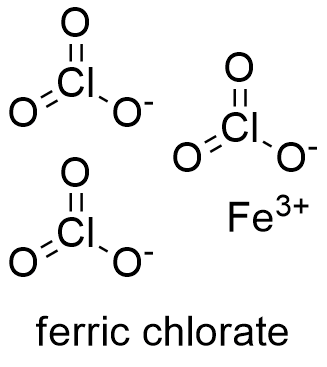Ferric chloride Formula
Ferric chloride, also known as iron (III) chloride, is an inorganic salt used as catalyst or intermediate in chemical industry. It is also used in the treatment of wastes.
Formula and structure: the anhydrous ferric chloride formula is FeCl3. However, there are two additional structures that can represent the ferric chloride found in nature and industry; the hexahydrate form, which has the chemical formula FeCl3.6H2O, and the tetra-aquadichloroiron (III) or rans form with the chemical formula [Fe(H2O)4Cl2]Cl.2H2O. The anhydrous and hexahydrate ferric chloride molar mass is 162.2 g mol-1 and 270 g mol-1 respectively. Anhydrous ferric chloride salt has an octahedral geometry, with Fe+3 ions bind to two chloride ligands. The chemical structures for the anhydrous and hexahydrate ferric chloride can be written as below, in the common representations used for organic molecules.

Occurrence: ferric chloride is rarely found as free compound in nature. It can be found in some minerals as molysite, which is a present in areas of volcanic activity. Sometimes, the ferric chloride is also called molysite.
Preparation: there are several procediments to prepared ferric chloride in its anhydrous or hexahydrate configuration. The simplest process is the direct chlorination by reacting iron and chlorine in their elemental configuration
2 Fe(s) + 3 Cl2(g) → 2 FeCl3(s)
Additionally, there are other methods such as oxidation of iron (II) chloride (reaction I) or reaction of ferric oxide with hydrochloric acid (reaction II):
2FeCl2(s) + Cl2(g) → 2 FeCl3(aq) (reaction I)
Fe3O4(S) + 8 HCl(aq) → FeCl2(aq) + 2FeCl3(aq) + 4 H2O (reaction II)
Physical properties: anhydrous ferric chloride is a salt, which in general present an orange-brown color. Sometimes, the ferric chloride crystal can have a dark green color. Its melting point is 304 ºC and its density is 2.8 g mL-1. Its soluble in water but reacts exothermically and the resulting solution is very corrosive. It is soluble in organic solvents.
Chemical properties: ferric chloride is formed by the cation Fe+3, which a metal transition element with d-orbital available to accept electrons, thus the ferric chloride is a weak Lewis acid and it can be used as catalyst in organic synthesis. The Fe+3 is a cation with small size and very charged, thus it is rapidly hydrolyzed by water molecules to form the hexahydrate complex.
Uses: Ferric chloride is used water treatment due its capacity to react in water to a corrosive and acid solution. It is used in electronic industry to print circuit boards due ferric chloride can etch the copper by promote the oxidation from copper (I) to (II). Ferric chloride is part of the chemical process to produce PVC by catalyzing the obtainment of the intermediate ethylene dichloride.
Health effects/safety hazards: ferric chloride is very toxic and corrosive to the skin, eyes and other mucous. It can cause the death by ingestion. When heated, ferric chloride can produce toxic gases.
|
Related Links: |
